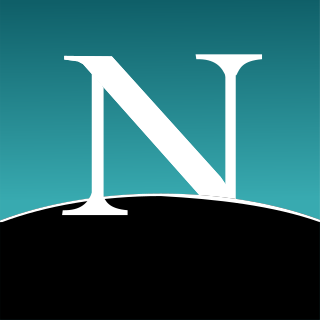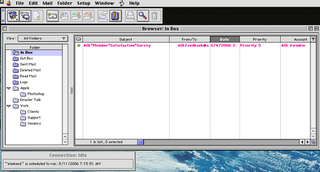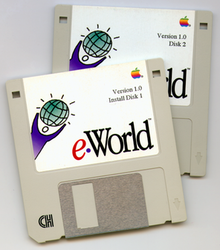
AOL is an American web portal and online service provider based in New York City. It is a brand marketed by Yahoo! Inc.

AIM was an instant messaging and presence computer program created by AOL, which used the proprietary OSCAR instant messaging protocol and the TOC protocol to allow registered users to communicate in real time.

Netscape Navigator is a discontinued proprietary web browser, and the original browser of the Netscape line, from versions 1 to 4.08, and 9.x. It was the flagship product of the Netscape Communications Corp and was the dominant web browser in terms of usage share in the 1990s, but by around 2003 its user base had all but disappeared. This was partly because the Netscape Corporation did not sustain Netscape Navigator's technical innovation in the late 1990s.
Netscape Communications Corporation was an American independent computer services company with headquarters in Mountain View, California, and then Dulles, Virginia. Its Netscape web browser was once dominant but lost to Internet Explorer and other competitors in the so-called first browser war, with its market share falling from more than 90 percent in the mid-1990s to less than one percent in 2006. An early Netscape employee Brendan Eich created the JavaScript programming language, the most widely used language for client-side scripting of web pages and a founding engineer of Netscape Lou Montulli created HTTP cookies. The company also developed SSL which was used for securing online communications before its successor TLS took over.

CompuServe was an American online service, the first major commercial one in the world. It opened in 1969 as a timesharing and remote access service marketed to corporations. After a successful 1979 venture selling otherwise under-utilized after-hours time to Radio Shack customers, the system was opened to the public, roughly the same time as The Source. H&R Block bought the company in 1980 and began to more aggressively advertise the service.
An online service provider (OSP) can, for example, be an Internet service provider, an email provider, a news provider (press), an entertainment provider, a search engine, an e-commerce site, an online banking site, a health site, an official government site, social media, a wiki, or a Usenet newsgroup.

Prodigy Communications Corporation was an online service from 1984 to 2001 that offered its subscribers access to a broad range of networked services. It was one of the major internet service providers of the 1990s.
AppleLink was the name of both Apple Computer's online service for its dealers, third-party developers, and users, and the client software used to access it. Prior to the commercialization of the Internet, AppleLink was a popular service for Mac and Apple IIGS users. The service was offered from about 1986 to 1994 to various groups, before being superseded by their short-lived eWorld and finally today's multiple Apple websites.
Apple Open Collaboration Environment (AOCE) is a collection of messaging-related technologies introduced for the Classic Mac OS in the early 1990s. It includes the PowerTalk mail engine, which is the primary client-side interface to the system, the PowerShare mail server for workgroup installations, and a number of additional technologies such as Open Directory, encryption, and digital signature support.

Internet Explorer for Mac was a proprietary web browser developed by Microsoft for the Macintosh platform to browse web pages. Initial versions were developed from the same code base as Internet Explorer for Windows. Later versions diverged, particularly with the release of version 5, which included the cutting-edge, fault-tolerant and highly standards-compliant Tasman layout engine.

Microsoft Internet Explorer 4 (IE4) is the fourth, and by now, discontinued, version of the Internet Explorer graphical web browser that Microsoft unveiled in Spring of 1997, and released on September 22, 1997, primarily for Microsoft Windows, but also with versions available for the classic Mac OS, Solaris, and HP-UX and marketed as "The Web the Way You Want It".

Claris Emailer is a discontinued e-mail client for the classic Mac OS created by Fog City Software. It was bought and marketed by the Apple Inc. subsidiary Claris. In addition to internet email, it supported sending and receiving email to online services such as AOL, Applelink, Compuserve. It was the only third-party e-mail client licensed to directly access AOL e-mail. Additionally, it was one of the first commercial applications to support the Internet Config preferences management system.

The Mozilla Application Suite is a discontinued cross-platform integrated Internet suite. Its development was initiated by Netscape Communications Corporation, before their acquisition by AOL. It was based on the source code of Netscape Communicator. The development was spearheaded by the Mozilla Organization from 1998 to 2003, and by the Mozilla Foundation from 2003 to 2006.

FirstClass is a client–server groupware, email, online conferencing, voice and fax services, and bulletin-board system for Windows, macOS, and Linux. FirstClass's primary markets are the higher-education and K-12 education sectors, including four of the top ten largest school districts in the United States.
Barry Martin Schuler is an American Internet entrepreneur and former chairman and CEO of America Online Inc. He is best known for leading the AOL team that simplified the online service provider's user interface, making it possible for millions of consumers to gain easy access to the Internet.

The Berkeley Macintosh Users Group, or more commonly "BMUG", was the largest Macintosh User Group. It was founded in September 1984 by a group of UC Berkeley students including Reese Jones and Raines Cohen as a focal-point for the nascent Apple Macintosh user community. With more than 13,000 members, or "BMUGgers" at its peak in 1993, the group was the largest, and generally understood to be the most important, Macintosh users group. A few of the notable members include John "Captain Crunch" Draper, the Sultan of Brunei Hassanal Bolkiah, notorious murderer Enrique Zambrano, early hacker-chaser Cliff Stoll, Inktomi founder Eric Brewer, and may prominent computing journalists like John Dvorak, Ilene Hoffman, Leo Laporte and Adam Engst. An example of the group's omnipresent blue-floppy-disk lapel pin is held in the Smithsonian Institution's American History collection. BMUG's history and activities were closely linked with the MacWorld Expo meetings, traditionally held in San Francisco each January and Boston each August.

The Pippin is a defunct open multimedia technology platform, designed by Apple Computer. According to Apple, Pippin was directed at the home market as "an integral part of the consumer audiovisual, stereo, and television environment".
MobileMe is a discontinued subscription-based collection of online services and software offered by Apple Inc. All services were gradually transitioned to and eventually replaced by the free iCloud, and MobileMe ceased on June 30, 2012, with transfers to iCloud being available until July 31, 2012, or data being available for download until that date, when the site finally closed completely. On that date all data was deleted, and email addresses of accounts not transferred to iCloud were marked as unused.
InterCon Systems Corporation was founded in April 1988 by Kurt D. Baumann and Mikki Barry to produce software to connect Macintosh computers in environments that were not Macintosh-exclusive. At the time, there was no real concept of the Internet and there was still a question of whether the TCP/IP protocols or OSI protocols would be adopted widely. Over the next 9 years, the company grew from three employees to over 100 and sold software in the US, Europe and Japan.

MSN Dial-up is an Internet service provider operated by Microsoft in the United States and formerly also in several other countries. Originally named The Microsoft Network, it debuted as a proprietary online service on August 24, 1995, to coincide with the release of Windows 95. In 1996 and 1997, a revised web-based version of the ISP was an early experiment at interactive multimedia content on the Internet.













